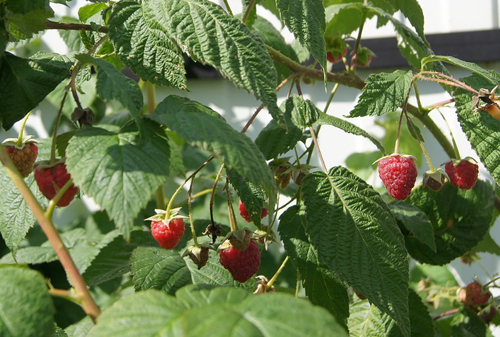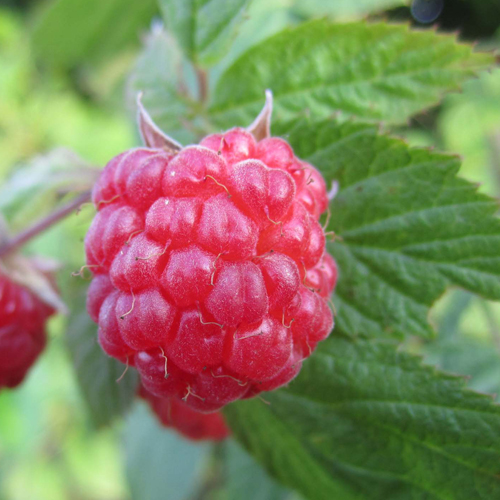Raspberry variety Gusar
Everyone knows that diseases harm plants. But many do not fully understand which one, devoting little time to prevention and treatments. And then they are sincerely surprised that the berry is not the same, and the taste is bad, and there was really no harvest. Often, diseases simply lead to the death of raspberries. Especially if pests help them in this. It hurts to watch how yesterday a beautiful and healthy plant just withers away today ... Unfavorable weather conditions (rain, cold, heat

History of creation
This summer raspberry was bred by well-known Russian breeders - Academician of the Russian Academy of Agricultural Sciences I.V. Kazakov, V.L. Kulagina and Professor S.D. Aitzhanova, another star in the firmament of domestic breeding, only in the strawberry area. Work on the creation of new items was carried out at the Kokinsky support point (Bryansk region). Cross-pollination of the American Canby cultivar was carried out with a mixture of pollen from virus-resistant and heat-resistant varieties. And the Gusar himself was selected in 1995 among the elite seedlings grown from seeds obtained from the Canby cross-pollination. Russian patent No. 0646 was issued in 2000. Patent expiration date -
Description
A universal variety, medium early ripening, begins to sing from July 15-20, in the southern regions from early July. The raspberry bush is tall, has a strong growth force, but compact, usually consists of 5-7 shoots. They are strong, of medium thickness, grow straight, 1.8-2 meters high, with good agricultural technology they can reach 2.5-3 meters. Shoots are weakly thorny, spines of medium size, straight, dark purple, few in number and are found mainly in the lower part of the shoot. Above to the apex, their number and size decreases, gradually they turn into just small tubercles. Husar laterals are strong, resilient, not very long, practically naked, resistant to breaking off under the weight of the crop.

Young shoots are green, in the second year they grow stiff, turn greenish-brown, laterals acquire an anthocyanin hue. Medium covered with a waxy coating, no pubescence of the stems. Raspberry root shoots give an average amount, there will be no special problems with its cutting. Nettle for non-mass reproduction is quite enough. The leaves are large, oval, slightly twisted, slightly pubescent, wrinkled, dark green above, whitish below. The denticles along the edges of the leaf are medium sharp. The flowers of the variety are small, white, on average 1 cm in diameter, collected in a brush, flowering begins in June.
Husar's bush is sprawling, without a trellis it "falls apart" under the weight of the harvest and can lie on the ground. Therefore, it is necessary to use a trellis, with a stalk tie to it in two places at a height of 50-70 cm and 1.2-1.5 meters, depending on the height of the shoots. Planting is recommended with a distance between bushes in a row of 80-100 cm or 50 cm when standardizing stems to 10-12 pieces per 1 running meter of a row. For better branching and increased yields, you can prune the top at a height of about 1.5 meters.

Raspberry berries are wide, blunt-conical in shape. Fruits are medium and large, with a minimum weight of 3 grams, and on average 3.5-5 grams, can be very large, up to 7-10 grams. The berries are bright red, in full ripeness, rich, ruby color with a glossy sheen.The length of the fruits is mainly 2.5-3 cm. The flesh of the Hussar is dense, but juicy. Drupes are uniform, medium in size, tightly adhered to each other. The seeds in them are large and felt when consumed. The skin of the fruit is firm. The berries are easily and dryly removed from the bush. They do not crumble during collection and hang on the bush for a long time without shedding. Fruits ripen in numerous clusters of 15–20 pieces, densely and compactly arranged. Thanks to the strong skin and dense pulp, the transportability and keeping quality of this variety is at a high level.
Raspberries have a very good taste, sweet and sour. Sugar and acid in them are well balanced, this has a positive effect on taste. Moreover, sweets are noticeably more than acids. Gusar berries contain: sugar 6.98-10.8%, acids 1.69-1.80%, vitamin C 27.2-37.18 mg /%. The content of P-active catechins is from 100 to 200mg / 100g. Catechins are organic substances from the flavonoid group. They are polyphenolic compounds and are powerful antioxidants that strengthen the cardiovascular system, reduce the risk of cancer and promote weight loss. Their content is high, for example, in green tea known for its beneficial properties - 300-400mg / 100g.

Gusar fruits for universal use. Perfect for personal consumption and for successful trading in the market. Large, beautiful, tasty and aromatic berries always attract the attention of buyers and are in demand when sold. Moreover, our hero is interesting both for ordinary summer residents and farmers who plant raspberries in large quantities. Indoor cultivation is possible (tunnels, greenhouses). The berries make excellent compotes, preserves, jams, they are also ground with sugar for the winter, used in cooking and homemade baking. Fruits are very good for freezing, after thawing they remain intact, retaining their structure. Suitable for drying. According to reviews, Gusar is one of the best domestic summer varieties in terms of a set of characteristics.
The average yield in the country is 8.36 tons per hectare, with competent agricultural technology, you can get 10-11 t / ha. An average of 3 kg of fruit is removed from the bush, but it is possible to collect 5-6 kg, everything will depend on the conditions created. To ensure a good yield and size of berries, regular fertilizing and the introduction of organic matter into the soil are necessary. And, of course, it is necessary to provide raspberries with a sufficient amount of moisture, especially at the time of fruiting.
To the credit of the breeders, they coped with the task perfectly. And the Hussar, like a real soldier, steadfastly endures all negative natural phenomena, is resistant to diseases and some pests. Affected by stem gall midge (control measures - leaf treatment with insecticides, Aktara
In the end, I would like to draw conclusions about the advisability of growing Gusar, knocking out all its pros and cons.
Strengths
- Good and stable yields.
- Large beautiful berries with a dry separation.
- Low-spine shoots, spines mainly in their lower part.
- Good transportability and keeping quality of fruits.
- A berry with a sweet and sour taste with a predominance of sweetness, with a rich raspberry aroma.
- Resistant to a wide range of raspberry diseases and some pests.
- Powerful vigor of growth of the bush, a small amount of root growth, compact habit.
- Good frost resistance (tested down to -35 ° C), the variety is heat and drought tolerant.
- Hussar is undemanding to the soil in which it grows, is hardy and unpretentious.
- Suitability for cultivation both in a summer cottage and in industrial plantings in an open field.
- The versatility of using berries - personal consumption, processing, freezing, drying
etc.
Weak sides
- Today there are varieties with much higher yields and larger berry sizes.
- Mandatory installation of a trellis and a garter of shoots.
- The taste of berries is dessert, but there are raspberries, of course, tastier and sweeter.
Well, as you can see, comparing the strengths and weaknesses, Gusar is really very good, perhaps one of the best varieties of domestic breeding in our market. And numerous reviews of gardeners grateful to him confirm this!
Author: Maxim Zarechny.









I have this variety - it has been growing for a long time (I bought it as a novelty and since then I have been absolutely happy with it). Raspberries of an early ripening period - on my site ripens one of the first, stretched fruiting (lasts 3-4 weeks), the berries are large, juicy, tasty (children really like it, but you can't fool them). We use it mainly fresh - right from the bush, I do not process it (I think that there is nothing to spoil a useful berry with thermal exposure), I freeze it a little - after defrosting, the berry keeps its shape well and does not sour. My raspberries practically do not get sick, only the weevil pesters me - I have to treat it with a solution of ammonia several times a season.